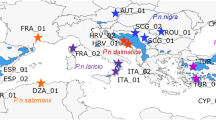Summary
This study demonstrates the impact of natural factors and human activities on biodiversity at gene level on a keystone Mediterranean forest ecosystem species. We monitored the within and among population gene diversity of Cedrus libani, a forest tree species of the Eastern Mediterranean mountains. We used paternally inherited chloroplast microsatellites (57 haplotypes) and bi-parentally inherited isozymes (12 loci) to estimate allelic richness, heterozygosity, and differentiation in 18 natural and 1 planted populations from Turkey and Lebanon. We showed that there is a phylogeographic structure in C. libani, and that forests from Lebanon and Turkey constitute two genetically isolated groups which probably arose from distinct refugia after the last Quaternary glacial cycle. We found extensive gene flow and relatively low differentiation in Turkey, as well as little evidence of genetic drift within populations. However, one population we analyzed, which was planted more than 20 centuries ago, and is isolated from core populations in Turkey, demonstrated extremely low genetic diversity and deserves high conservation priority. In contrast, we found low gene flow, high differentiation and severe cases of genetic drift in Lebanon. As forests there are the remnants of millennia-long extensive deforestation, all deserve high conservation priority.



Similar content being viewed by others
References
Alptekin CU, Bariteau M, Fabre JP (1997) Le cèdre de Turquie : aire naturelle, insectes ravageurs, perspectives d’utilisation pour les reboisements en France. Rev Forestière Fr 49(1):19–31
Austerlitz F, Mariette S, Machon N, Gouyon P-H, Godelle B (2000) Effects of colonization processes on genetic diversity: differences between annual plants and tree species. Genetics 154:1309–1321
Bou Dagher-Kharrat M (2001) Caractérisation du génome et structuration géographique de la diversité génétique du genre Cedrus. Doctoral Thesis, University Pierre and Marie Curie, Paris, France
Boydak M (2003) Regeneration of Lebanon cedar (Cedrus libani A. Rich.) on karstic lands in Turkey. For Ecol Manage 178:231–243
Davis PH (1965) Flora of Turkey and East Eagean islands, vol 1. University Press, Edinburgh, pp 71–72
El Mousadik A, Petit RJ (1996) High level of genetic differentiation for allelic richness among populations of the argan tree (Argania spinosa L Skeels) endemic of Morocco. Theor Appl Genet 92:832–839
Fady B (2005) Is there really more biodiversity in Mediterranean forest ecosystems? Taxon 54(4):905–910
Fady B, Conkle MT (1992) Segregation and linkage of allozymes in seed tissues of the hybrid Greek fir Abies borisii regis Mattfeld. Silvae Genet 41(4/5):273–278
Fady B, Lefèvre F, Reynaud M, Vendramin GG, Bou Dagher-Kharrat M, Anzidei M, Pastorelli R, Savouré A, Bariteau M (2003) Gene flow among different taxonomic units: evidence from nuclear and cytoplasmic markers in Cedrus plantation forests. Theor Appl Genet 107(6):1132–1138
Fallour D, Fady B, Lefèvre F (2001) Evidence of variation in segregation patterns within a Cedrus population. J Hered 92(3):260–266
Greuter W, Burdet HM, Long G (1984) Med-checklist 1. Conservatoire et Jardin Botanique de la ville de Genève. Genève, Switzerland
Hamrick JL, Godt MJW, Sherman-Broyles SL (1992) Factors influencing levels of genetic diversity in woody plant species. New For 6:95–124
Hewitt G (2000) The genetic legacy of the Quaternary ice ages. Nature 405:907–913
Kayihan GC (2000). The genetic structure of Cedrus libani A. Rich populations determined by DNA markers. Masters thesis, Middle East Technical University, Ankara
Ladjal M, Huc R, Ducrey M (2005) Drought effects on hydraulic conductivity and xylem vulnerability to embolism in diverse species and provenances of Mediterranean cedars. Tree Physiol 25(9):1109–1117
Le Corre V, Kremer A (2003) Genetic variability at neutral markers, quantitative trait loci and trait in a subdivided population under selection. Genetics 164:1205–1219
Luikart G, Allendorf FW, Cornuet JM, Sherwin WB (1998) Distortion of allele frequency distributions provides a test for recent population bottlenecks. J Hered 89(3):238–247
Nei M (1972) Genetic distance between populations. Am Nat 106:283–292
Nei M (1973) Analysis of gene diversity in subdivided populations. Proc Natl Acad Sci USA 70: 3321–3323
Petit RJ, Duminil J, Fineschi S, Hampe A, Salvini D, Vendramin GG (2005) Comparative organization of chloroplast, mitochondrial and nuclear diversity in plant populations. Mol Ecol 14(3):689–701
Pons O, Petit RJ (1996) Measuring and testing genetic differentiation with ordered and unordered alleles. Genetics 144:1237–1245
Provan J, Soranzo N, Wilson NJ, Goldstein DB, Powell W (1999) A low mutation rate for chloroplast microsatellites. Genetics 153:943–947
Quézel P, Médail F (2003) Ecologie et biogéographie des forêts du bassin méditerranéen. Elsevier, Paris
Rajora OP, Rahman MH, Buchert GP, Dancik BP (2000) Microsatellite DNA analysis of genetic effects of harvesting in old-growth eastern white pine (Pinus strobus) in Ontario, Canada. Mol Ecol 9:339–348
Robledo-Arnuncio JJ, Alia R, Gil L (2004) Increased selfing and correlated paternity in a small population of a predominantly outcrossing conifer, Pinus sylvestris. Mol Ecol 13:2567–2577
Rogers SO, Kaya Z (2006). DNA from ancient cedar wood from King Midas Tomb, Turkey, and Al-Aksa Mosque, Israel. Silvae Genet 55(2):54–62
Saitou N, Nei M (1987) The neighbor-joining method: a new method for reconstructing phylogenetic trees. Mol Biol Evol 4(4):406–425
Scaltsoyiannes A (1999) Allozyme differentiation and phylogeny of cedar species. Silvae Genet 48(2):61–68
Talhouk SN, Zurayk R, Khuri S (2001) Conservation of coniferous forests of Lebanon: past, present and future prospects. Oryx 35(3):206–215
Young A, Boyle T, Brown T (1996) The population genetic consequences of habitat fragmentation for plants. Trends Ecol Evol 11(10):413–418
Zeist W van, Woldring H, Stapert D (1975) Late quaternary vegetation and climate of southwestern Turkey. Palaeohistoria 17:53–144
Acknowledgements
We are grateful to D. Vauthier for collecting plant material and to B. Jouaud for laboratory assistance. This work was funded by the project FAIR CT95-0097 “Adaptation and selection of Mediterranean Pinus and Cedrus for sustainable afforestation of marginal lands" financed by the Commission of the European Communities.
Author information
Authors and Affiliations
Corresponding author
Rights and permissions
About this article
Cite this article
Fady, B., Lefèvre, F., Vendramin, G.G. et al. Genetic consequences of past climate and human impact on eastern Mediterranean Cedrus libani forests. Implications for their conservation. Conserv Genet 9, 85–95 (2008). https://doi.org/10.1007/s10592-007-9310-6
Received:
Accepted:
Published:
Issue Date:
DOI: https://doi.org/10.1007/s10592-007-9310-6




